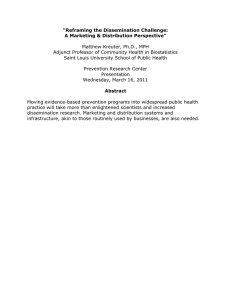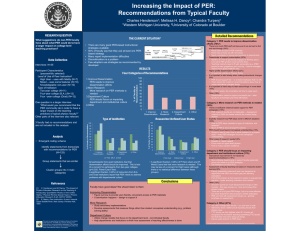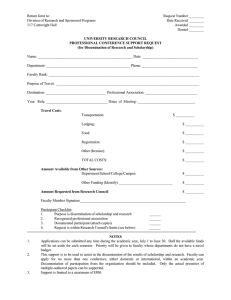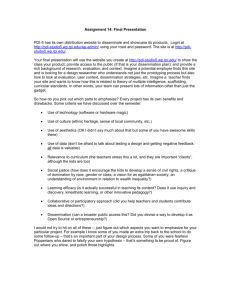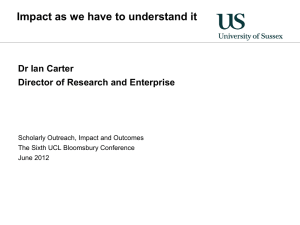Increasing the Impact of PER: Recommendations from Typical Faculty Charles Henderson*
advertisement
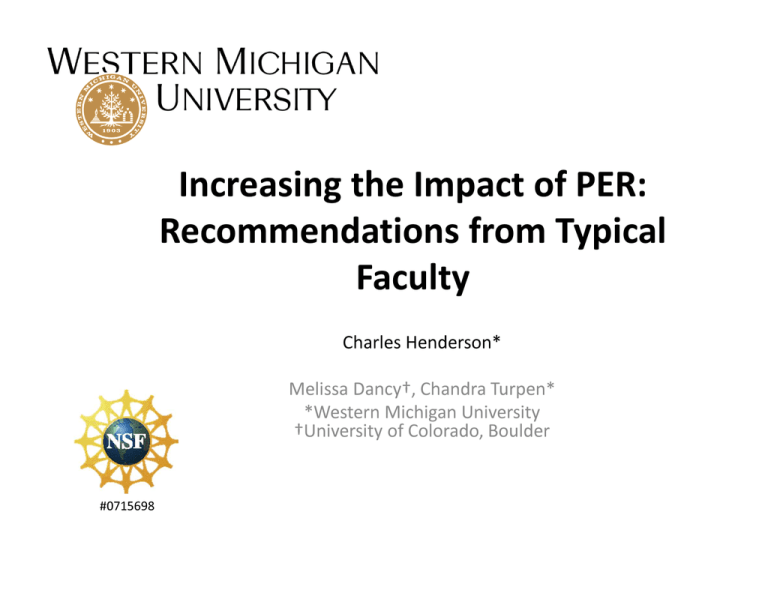
Increasing the Impact of PER: Recommendations from Typical Faculty Charles Henderson* Melissa Dancy†, Chandra Turpen* *Western Michigan University †University of Colorado, Boulder #0715698 The Current Situation • There are many good PER-based instructional strategies available* – 50% of faculty say that they use at least one But – Many report implementation difficulties – Discontinuation is a problem – Few use strategies as recommended by developer • Big question -> How can PER do a better job of supporting the spread of PER products? • This talk -> What suggestions do non-PER faculty have about what PER could do better? *Henderson, C. & Dancy, M. (2009) The Impact of Physics Education Research on the Teaching of Introductory Quantitative Physics in the United States, Physical Review Special Topics: Physics Education Research, 5 (2), 020107. Data Collection • Interviews: N=35 – Level of Use of Peer Instruction • High User – uses with fidelity (N=7) • Mixed User – uses some features (N=18) • Knowledgeable non-user (N=10) – Type of Institution • Two-year college (N=11) • Four-year college (B.A.) (N=12) • Four –year college (Grad) (N=12) • “What would you recommend that the PER community do in order to have a larger impact on the teaching practices of typical physics faculty?” • 3 faculty had no recommendations and were removed from this analysis Analysis • Identify statements from transcripts with recommendations for PER (N=125) • Emergent coding scheme – Group statements that are similar – Cluster groups into categories Category 1 Category 2 Category 3 Other Results Main Categories PER needs to improve dissemination efforts 2. More Research More research on PER methods is needed 3. Department Culture PER should focus on impacting department and institutional culture 4. Other % of Faculty w/ Recommendation 1. Improve Dissemination 100 90 80 70 60 50 40 30 20 10 0 1. Improve 2. More Research 3. Department Dissemination Culture 4. Other Improved Dissemination PER needs to improve dissemination efforts 1. Hard to find PER Stuff (34%) • There is so much PER stuff out there and it can be hard to find and sort through. – – – Need easier access to PER materials Need ways to keep up with new ideas Have consultants to recommend solutions to departments 2. Disseminate to support customization (25%) • • Need to do more to get faculty engaged in thinking about how they could customize a PER product to work for them. Teaching methods need to fit with personality. 3. Higher profile dissemination efforts (22%) • e.g., Articles in Physics Today More Research More research on PER methods is needed 1. PER Results not believable (16%) • Assessment methods in PER are biased towards the method being studied 2. How do PER ideas work in different situations? (16%) • Much of PER is done at large R1 schools. What about other types of institutions and students? 3. PER should focus beyond conceptual understanding (13%) • There are many other important instructional goals, e.g., problem solving Department Culture PER should focus on impacting department and institutional culture 1. Instructional Improvement not valued by departments/institutions (19%) • • More lobbying departments to support faculty (especially junior) who want to try PER strategies Get institutions to value SoTL 2. Assessment of faculty teaching not based on measures of student learning (9%) • • Faculty who experiment with PER may get poor teaching evaluations Part of the problem is that research is easier to evaluate than teaching. 3. Other (13%) • • There a lot of good PER things, but to be most effective the whole department needs to be on board. PER can help with assessment issues (i.e., growing emphasis on assessment) % of Faculty w/ Recommendation Recommendations by Institution Type 100 90 80 70 60 50 40 30 20 10 0 2-Year (N=10) B.A. (N=11) Grad (N=11) 1. Improve Dissemination 2. More Research 3. Department Culture 4. Other • Faculty at grad institutions see dissemination efforts as more problematic than instructors from two-year colleges (p=0.035, Fisher Exact Test). • Many (>25%) instructors from B.A. and Grad institutions report that PER needs to address problems with departmental culture. % of Faculty w/ Recommendation Recommendations by User Type* 100 90 80 70 60 50 40 30 20 10 0 Non-User (N=8) Mixed User (N=17) High User (N=7) 1. Improve Dissemination 2. More Research 3. Department Culture 4. Other • Many (>25%) of PI Non-Users and PI Mixed Users report that PER needs to conduct more research on PER RBIS. This may be less of a concern for High Users (although there is no statistical difference between these groups). *User Type is defined based on researchers characterizing interviewee’s reported practices. Conclusions Faculty have good ideas! We should listen to them. Conclusions - Our Recommendations Improving Dissemination • Figure out how to provide user-friendly, convenient access to PER materials • Customization happens – design to support it. PER User’s Guide being developed by Sam McKagan: perusersguide.org Our Recommendations (cont.) More Research – Study secondary implementations (e.g., Sharma et al.) - Develop assessments that measure things other than student conceptual understanding (e.g., problem solving ability - Docktor and Heller) Our Recommendations (cont.) Department Culture – Utilize change models that focus on the department level - not individual faculty (e.g., U of IL) – Help departments and institutions re-think how assessment of teaching effectiveness is done (e.g., Turpen talk & poster) Thank You (Summary of Recommendations) Improving Dissemination • Figure out how to provide user-friendly, convenient access to PER materials • Customization happens – design to support it. More Research • Study secondary implementations • Develop assessments that measure things other than student conceptual understanding Department Culture • Utilize change models that focus on the department level not individual faculty • Help departments and institutions re-think how assessment of teaching effectiveness is
